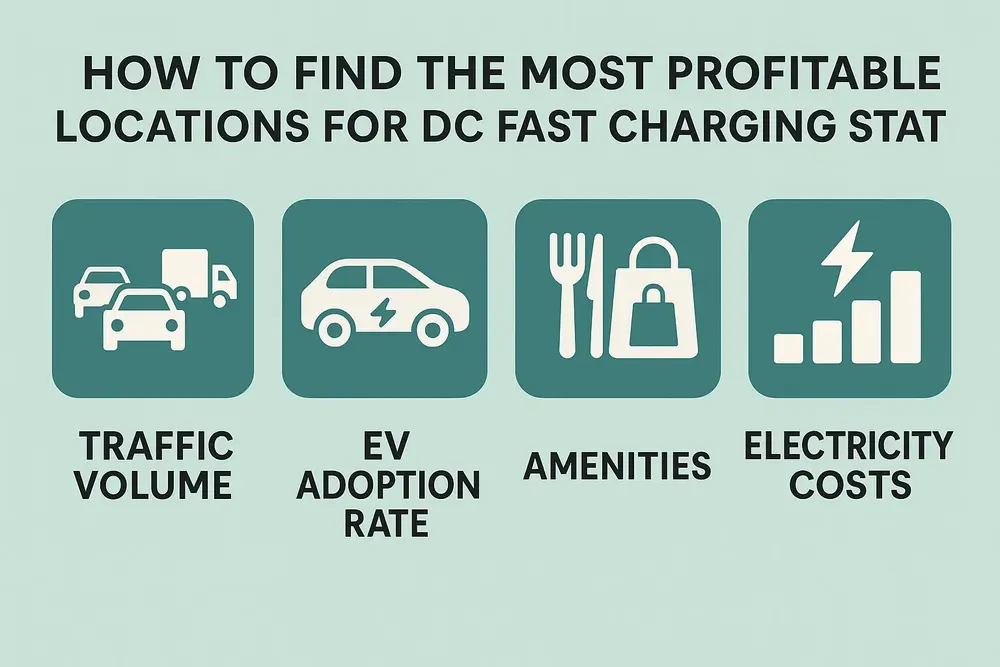How to Find the Most Profitable Locations for DC Fast Charging Stations
In the rapidly expanding electric vehicle (EV) ecosystem, the location of a DC fast-charging station can make or break the business. A well-chosen site can attract consistent traffic, ensure a fast return on investment, and serve as a scalable asset. A poor choice, on the other hand, can lead to high costs and underperformance. Here’s how to determine the most lucrative locations for installing DC fast chargers.

Why Location is a Strategic Priority
Successful DC fast-charging deployments start with one central question: where is the demand? Profitability hinges on a variety of elements—land quality, permitting requirements, proximity to the power grid, access to high-traffic areas, and potential for growth. But one consistent theme emerges: the more visible and accessible your station is to EV drivers, the greater your earning potential.
Key Traits of High-Return Charging Sites
- Located in densely populated or highly trafficked areas
- High EV adoption rates in the region
- Minimal competition nearby
- Simple, cost-effective site preparation
- Proximity to major roads or destinations
- Ease of access for customers and technicians
- Room for expansion
What Influences Charging Behavior
Understanding your customer base is essential. For example:
- Commuter Corridors: These require fast turnarounds and benefit from rapid DC charging stations.
- Workplaces: Employees parked for 6–8 hours don’t need high-speed charging.
- Shopping Centers or Restaurants: Medium to fast-charging solutions can be ideal for 30–90 minute stops.
Top 5 Location Considerations
1. Analyze Customer Demographics
Young, employed professionals and tech-savvy populations are the early adopters of EVs. Use regional data to assess where these groups live and work. Overlay this with EV registration statistics for added insight.
2. Evaluate Nearby Traffic
Look for locations on major highways, urban intersections, or close to public transport nodes. Both en-route and destination traffic are valid sources of demand. High-traffic shopping centers, stadiums, and gyms can also be ideal.
3. Check Infrastructure Feasibility
Assess the condition of the land. Avoid areas prone to flooding or requiring major earthwork. A flat, stable surface close to the grid will reduce construction costs and time.
4. Review Grid Access
DC fast chargers consume significant power. Ensure the site is near a substation or has sufficient electrical capacity. Remote areas may incur large expenses just to establish a connection.
5. Understand Regulatory Framework
Zoning, permits, and environmental compliance vary across regions. Engage early with local authorities to identify restrictions and approval processes. Delays in permitting can derail otherwise promising projects.
Bonus Tips for Maximizing Profitability
- Offer Value-Added Services: Coffee stands, vending machines, or convenience stores can create additional revenue streams.
- Design for Scalability: Reserve space for more chargers in the future.
- Use Management Software: Monitor usage, set pricing, and balance loads with smart charging platforms.
- Consider Mixed Charging Models: Blend Level 2 and DC fast chargers to accommodate various customer needs.
ROI Calculation: The Final Check
A high-traffic location with low setup cost and limited competition offers the best ROI. But remember to factor in:
- Cost of installation and grid connection
- Land lease or purchase price
- Ongoing maintenance and staffing
- Local incentive programs that offset CAPEX
Conclusion
The success of a DC fast-charging station begins with location. Prioritize customer convenience, future scalability, and infrastructural feasibility. A strategically chosen site not only serves today’s EV drivers but positions your business for long-term growth in the electrified future.

